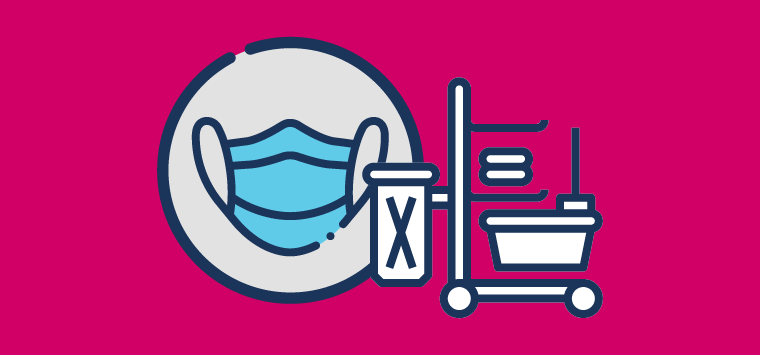Healthcare Cleaning Services Post COVID-19
Healthcare cleaning services evolved due to COVID-19, as the demand for deep cleaning grew exponentially. Cleaning professionals accepted increased demands and took on added risks because disinfecting healthcare environments was vital to reducing the spread of the coronavirus.
Because of the increased demands, hospitals and clinics have higher cleaning standards that cleaning contractors are expected to continue providing. Those changes are still impacting companies. However, contract cleaning software can support those demands for medical and healthcare cleaning services on the heels of a global pandemic.
Increased healthcare cleaning protocols
Preliminary evidence showed that COVID-19 could survive on surfaces for up to three days. That meant that healthcare cleaning professionals were given the arduous task of minimising surface transmission of the virus. It was later established that the primary mode of transmission is through contact with an infected person.
At the onset of COVID-19, deep cleaning and disinfection methods were essential resources against the coronavirus. This was especially true inside a healthcare facility. The Occupational Safety and Health Administration (OSHA) published in the Federal Register an emergency temporary standard for occupational exposure. It required employers to take specific steps to protect their workers in settings where COVID-19 patients were treated.
In patient care areas and resident rooms, in addition to situations dealing with medical devices or equipment, employers were required to follow practices for cleaning and disinfection of surfaces and equipment in accordance with the Centers for Disease Control COVID-19 Infection Prevention and Control Recommendations. As part of the COVID-19 plan, employers must take steps to minimise avoidable exposure of employees like janitors and housekeeping personnel to persons with suspected or confirmed COVID-19, reads OSHA’s website.
In response to federal requirements, cleaning contractors received increased demands from clients. Some of those demands outlined specific Personal Protective Equipment (PPE). Other demands included commercial cleanser specifications, cleaning requirements and inspections. In some cases, that meant using cleaners and water to pre-clean surfaces before applying an EPA-registered, hospital-grade disinfectant to frequently touched surfaces or objects for appropriate contact times.
Strengthened communication methods
In addition to performing additional required physical acts, janitorial service companies were asked to be more communicative. Contractors were expected to communicate better about hazards on the worksite, procedures for controlling hazards and how to resolve any conflicts that could affect employee safety and health. Examples of increased communication requirements in responses to COVID-19 have included:
- Appointing a designated supervisor or manager capable of ensuring strong communication regarding expectations
- Maintaining a detailed inventory list of supplies and regularly updating that list
- Ensuring that employees understand how to clean specific areas and thoroughly communicate that information to new hires
- Regularly conducting routine inspections and keep logs of inventories
Additionally, communicating specific areas where cleaning and sanitization have been implemented, the time and dates of completion and the names and titles of the individuals who authorised and managed procedures were requested during this heightened period.
Despite the end of the public health emergency, cleaning companies, especially those specialising in medical cleaning services, may be still asked to maintain the same healthcare cleaning services and added communication requirements on current and future contracts.
Tech services for commercial cleaning companies
Proof of service
Showing proof that specific medical cleaning services were performed is one way to ensure protocols were taken. Contractors who provide janitorial services, and particularly healthcare cleaning services, can benefit from using proof of service to capture real-time information from the field through mobile forms.
With proof of service, it is possible to gather rich data in the form of photos, timestamps and locations. All of that information can be easily exported,shared or stored with back-office staff. It may also be shared with clients expecting hard evidence that protocols were met.
Additional proof of service procedures can minimise liability concerns. For example, in the event of an audit, a hospital or clinic may be asked to demonstrate their adherence to required cleaning standards for infection prevention and control. Non-compliance with any standards could result in serious health risks for patients, in addition to fines and penalties for the hospital. Alternatively, providing proof of service can highlight important details, such as processes taken, timelines and equipment used.
Communication tools
Similar to how proof of service can help contractors meet the demands of clients requiring more in-depth cleaning services, communication tools are also able to help managers determine the quality of service being performed.
With an integrated workforce management system, managers know that cleaners are active when they are on-site. Using real-time visibility tools, managers can track cleaners in real-time as they perform routine service. Communication tools provided in cleaning software solutions can also help mitigate on-site problems. Within software solutions, information is collected and then distributed to the appropriate personnel for immediate response.
Impact of COVID-19 on the cleaning industry
Throughout the COVID-19 pandemic, healthcare facilities hospitalised and monitored patients for days or sometimes weeks. Because of the risk of exposure, COVID-19 changed the healthcare industry as a whole. That also meant healthcare cleaning services experienced increased demands and higher cleaning standards from clients and health officials.
Although the pandemic has officially ended, some cleaning clients still expect those increased standards to remain in place. However, technical resources, such as an integrated workforce management system, can help contractors to continue to meet increased expectations.
For more information on how software tools designed to aid commercial cleaning contractors can help combat the repercussions of COVID-19 and dealing with work orders involving high-sanitisation cleaning, schedule a demo with one of our specialists.
